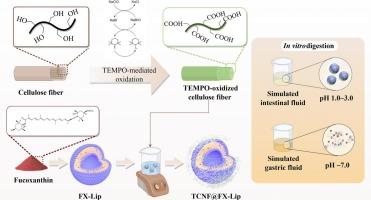Bionic cell wall models: Utilizing TEMPO-oxidized cellulose nanofibers for fucoxanthin delivery systems
IF 10.7
1区 化学
Q1 CHEMISTRY, APPLIED
引用次数: 0
Abstract
Fucoxanthin (FX) has various excellent biological properties but suffers from poor bioavailability. In this work, we build a bionic cell wall model using TEMPO (2,2,6,6-tetramethyl-1-piperidinyloxy)-oxidized cellulose. The bionic cell wall enhances the environmental stability of the liposomes and serves as a pH-responsive mechanism. The coating processes protect the structure of liposomes and fucoxanthin under the acidic conditions of the stomach. The bionic cell wall disperses and releases the fucoxanthin in simulated intestinal fluid (SIF). Overall, the protective and release capabilities highlight the potential of cellulose in a bionic cell wall model and provide diversity for the structural design of carriers for delivering functional bioactive components.

仿生细胞壁模型:将 TEMPO 氧化纤维素纳米纤维用于岩藻黄质输送系统
岩藻黄质(FX)具有多种优异的生物特性,但生物利用率较低。在这项工作中,我们利用 TEMPO(2,2,6,6-四甲基-1-哌啶基氧基)氧化纤维素建立了一个仿生细胞壁模型。仿生细胞壁增强了脂质体的环境稳定性,并作为一种 pH 响应机制。在胃的酸性条件下,包衣过程可保护脂质体和狐黄素的结构。仿生细胞壁可在模拟肠液(SIF)中分散和释放狐黄素。总之,保护和释放能力凸显了纤维素在仿生细胞壁模型中的潜力,并为输送功能性生物活性成分的载体结构设计提供了多样性。
本文章由计算机程序翻译,如有差异,请以英文原文为准。
求助全文
约1分钟内获得全文
求助全文
来源期刊

Carbohydrate Polymers
化学-高分子科学
CiteScore
22.40
自引率
8.00%
发文量
1286
审稿时长
47 days
期刊介绍:
Carbohydrate Polymers stands as a prominent journal in the glycoscience field, dedicated to exploring and harnessing the potential of polysaccharides with applications spanning bioenergy, bioplastics, biomaterials, biorefining, chemistry, drug delivery, food, health, nanotechnology, packaging, paper, pharmaceuticals, medicine, oil recovery, textiles, tissue engineering, wood, and various aspects of glycoscience.
The journal emphasizes the central role of well-characterized carbohydrate polymers, highlighting their significance as the primary focus rather than a peripheral topic. Each paper must prominently feature at least one named carbohydrate polymer, evident in both citation and title, with a commitment to innovative research that advances scientific knowledge.
文献相关原料
| 公司名称 | 产品信息 | 采购帮参考价格 |
|---|---|---|
| 上海源叶 |
Cholesterol
|
 求助内容:
求助内容: 应助结果提醒方式:
应助结果提醒方式:


